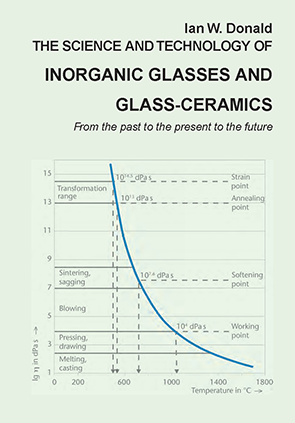Glass in Engineering Science: Volume 2, Glass under Load
by J. A. Hemsley
This second volume on glass in engineering science encompasses some particular aspects of glass subjected to applied loading, and comprises two distinct parts. The first deals with architectural glazing, based on three notable construction projects. The second is concerned with brittle fracture, based on the observed behaviour of glass cylinders under diametral compression.
Examples of the analysis and design of architectural glazing are described for selected international building projects, foremost among them being the celebrated Sydney Opera House. Because of the prevailing dearth of published technical data on the structural aspects of glazing, much of the basic flexural behaviour of glass panels had to be deduced from first principles, and then carried forward to practical design. Other problems associated with glazing integrity also required investigation, and although some of the details might nowadays be modified to suit current practice, the original underlying strategy remains substantially valid and intact. The theoretical background to this project work in establishing benchmark results for the elastic flexure of monolithic and laminated glass panels under static transverse loading is relegated to several appendices, which include extensive numerical results in graphical and tabular form incorporating previously unpublished material.
Early experimental results on the diametral compression of solid and hollow glass cylinders carried out by the writer are re-visited, in order to better understand the observed mode of fracture. The nature of this commentary assumes far wider influence in the important field of materials science, especially in regard to the tensile strength and fracture mechanics of brittle solids. It is emphasised that there can be appreciable difficulties in deducing tensile strength from this ubiquitous form of testing, while the fracture toughness of pre-cracked cylinders is also discussed. As before, summaries of theoretical analyses relating in this instance to the fundamental elastostatic problem of a cylinder in diametral compression are given in substantial appendices, and embrace hitherto unpublished results. Finally, to help draw together interrelated work in many disparate fields, a comprehensive bibliography is appended to cover most of the additional theoretical and experimental studies on diametrically compressed cylinders that have been reported worldwide in numerous publications.
First published November 2016, premium hardback, 757 pages (175 x 250 mm) with black and white and colour litho illustrations, ISBN 13-978-0-900682-75-9.
Glass Manufacture by Walter Rosenhain
Introduced by Professor Michael Cable Walter Rosenhain was one of the most outstanding of metallurgical researchers of his time. However, before resuming his metallurgical career on leaving Cambridge University in 1900, he worked for several years as chief scientific adviser to Chance Brothers of Smethwick. During that time he became fascinated by glass and retained that interest throughout his career. He wrote the first edition of this book in 1907 hoping that it might arouse interest in applying science in the glass industry. This second edition, published in 1918, reflected changes made as a result of that war but still showed little application of science. Contents pages of this publication can be found here Price: £ 25.00
Buy now at http://www.sgt.org/store/
Glass in engineering Science, Volume 1
Optical Birefringence in Glass
by J A Hemsley
The main objective of this monograph is to draw together those disparate strands of glass science and technology associated with optical birefringence. Throughout the text, a simplified approach has been adopted in presenting the salient features of what is often difficult subject matter, partly to encourage a wider readership. Theoretical and experimental results from many sources are presented, and copious references are given in full so that particular fields of enquiry can be pursued in greater depth where necessary. In this connection, additional emphasis is given to the historical origins of the various scientific discoveries and technological innovations, which often tend to be overlooked. Indeed, several examples of largely unknown publications have been identified and given deserved recognition herein. To some degree, therefore, the present compendium is a celebration of the pioneering investigations carried out worldwide by numerous scientists and engineers over the past two centuries. First published 2015, hardback, 687 pages, colour format (175 x 250 mm)
Buy now at http://www.sgt.org/store/
THE SCIENCE AND TECHNOLOGY OF
INORGANIC GLASSES
AND
GLASS-CERAMICS
From the Ancient to the Present to the Future
Ian W. Donald

Glass has a very long history spanning millennia and throughout the ages its unique combination of properties has made it one of the most useful class of materials known. This book covers an overview of a wide range of themes from within the general area of glass and glass-ceramic science and technology, from the ancient to the present to the foreseeable future, with each chapter covering a specific topic. It is aimed at scientific and technical staff working in the area of glass technology who wish to gain a greater appreciation of the diversity of materials and applications in this developing subject. It will also be of appeal to students in both the sciences and arts who have an interest in glass, and to a wider audience with a general interest in glass or environmental issues. A book of this nature cannot of course cover all aspects of glass science and technology in fine detail without running to several volumes. Consequently, some areas are covered in more detail than others, in line with the author’s extensive experience in those areas. The reader’s interest in any specific area may be followed up through the incorporation of a bibliography accompanying each chapter. The provision of a comprehensive bibliography makes the book a valuable reference source for all the major topics related to glass science and technology.
2015, 244 mm by 170 mm, 752 pages with black and white and colour illustrations
ISBN 978 0 900682 77 3
